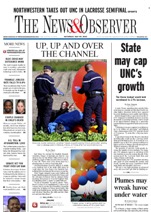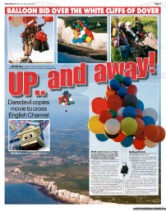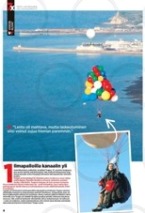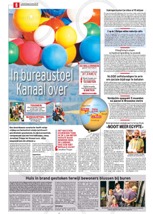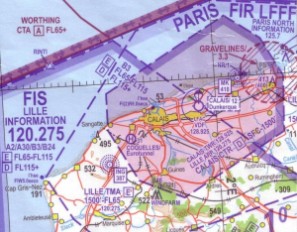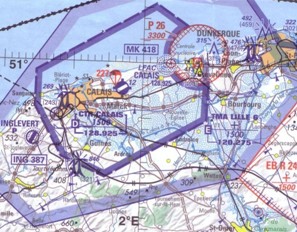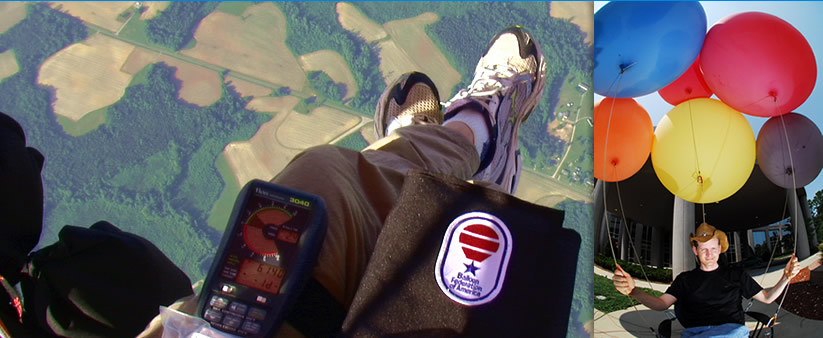Cluster Ballooning:
The English Channel!
From the UK to the Continent under a giant cluster of toy balloons: May 28, 2010
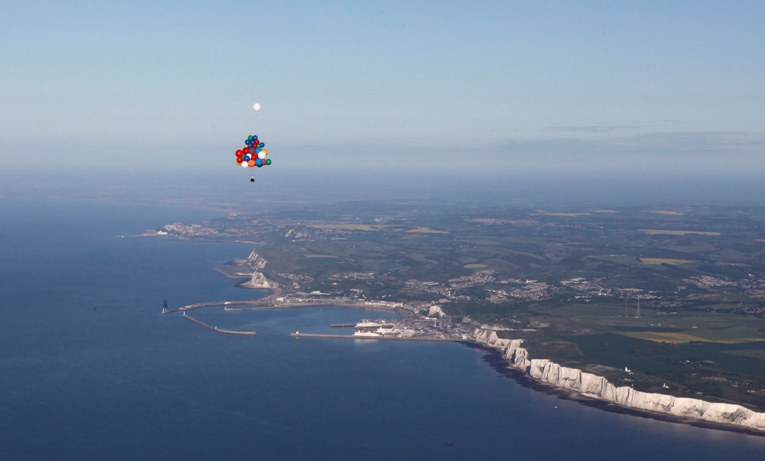
Departing England
Much has been written about the crossing of English Channel by cluster balloon. The following is the background text for an interview given to London's Financial Times in the time following the flight. Cole Moreton, interviewer. The interview itself was published in the FT Saturday magazine in a first-person format.
Part I:
Financial Times: I am expressly forbidden from doing this by email.
Trappe: Well, let’s charge forward then.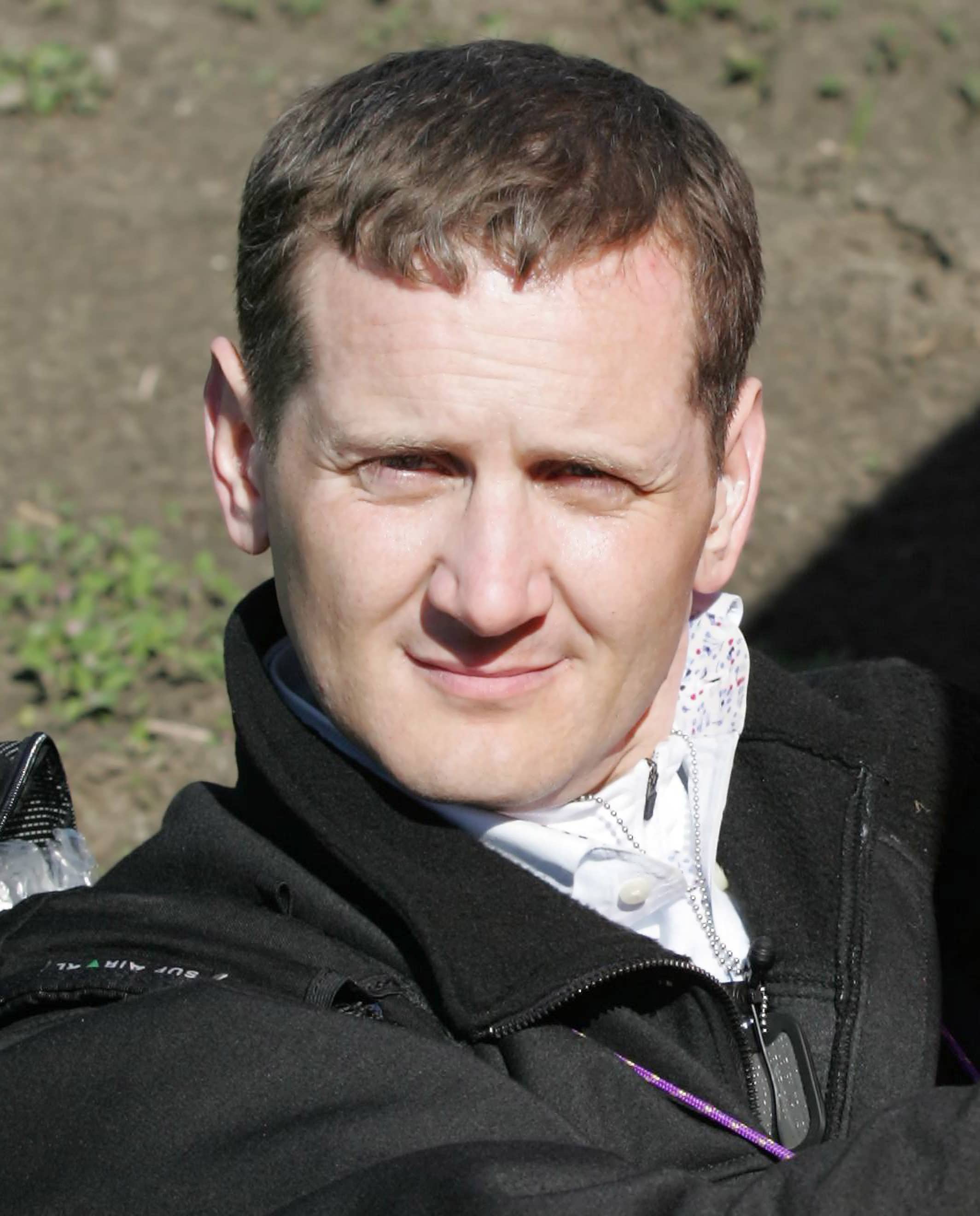
Financial Times: Who is…
Trappe: My name is Jonathan R. Trappe. I like the “R.” Most journalists drop it.
I am a Technical Projects Manager at Accenture, the global information technology consulting company. You see our ads in Heathrow. Right now, there is a picture of an elephant surfing. I suspect that has something to do with being both large and nimble. We help large clients (Fortune 500 companies, local, state, and federal governmental bodies) enact complex change. Frequently this involves large information systems.
I run technical projects-- for example, moving a running information system from one datacenter to another, without the end user noticing. Lots of moving bits. Don't drop any. They are fragile. Metaphorically.
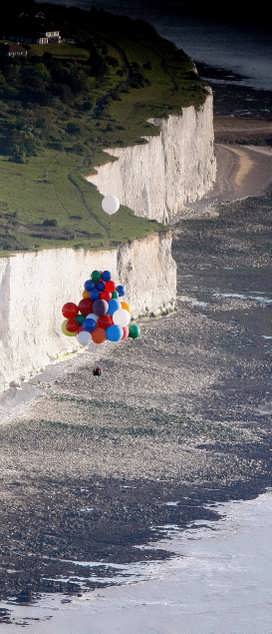
Financial Times: How he became interested…
Trappe: I first became interested the same way you first became interested. At least, if you are like the majority of humanity. You saw a balloon as a child, you wondered at it, and how it floated upon the air. Then, your mind started working, and you wondered “If I just get enough of these….couldn’t I go into the sky?”
We are usually told that this is not possible.
We become sensible adults. We leave this idea behind us. This dream of flight goes quiet. When I lift off from an airfield, attached to a towering cluster of toy balloons, I see true amazement and wonder in the eyes of children.
The miracle of this sport is that I see the same wonder in the eyes of their parents; the wonder of this sport is that it awakens a dream that so many of us once had, but has grown quiet.
Financial Times: And then became passionately interested…
Trappe: If you are going to do this right, you have to be passionately interested. You understand that we persuaded governmental agencies that flying toy balloons, in manned flight, internationally, across the English Channel, from England to France, could be done safely and legally.
Can you imagine the hurdles to overcome?
I would never use the word Byzantine to describe the process. However, others might. (Not me. Others.) There are substantial airworthiness and operational procedures to become familiar with, and to comply with. Make no mistake: the legal and regulatory compliance was not a simple undertaking. Try, just try, to get standard aviation insurance for a cluster of toy balloons. I challenge you.
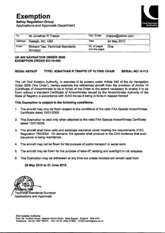 Or, equally daunting, try to persuade the CAA that you should be exempt from EASA insurance standards. Are you aware that you must carry an amount of insurance that is denominated in an imaginary currency? I was required to carry 750,000 SDR’s of insurance. You will never see an SDR. "Special Drawing Rights" are pretty thin on the ground. Pretty thin in the air, too. Generally, just pretty rare, in physical form. As a currency, it exists only in the abstract; you must convert it to a currency that is exists on-the-hoof. By contacting just about every insurance outlet we knew of, and many we discovered along the way, I got a $1-million USD policy.
Or, equally daunting, try to persuade the CAA that you should be exempt from EASA insurance standards. Are you aware that you must carry an amount of insurance that is denominated in an imaginary currency? I was required to carry 750,000 SDR’s of insurance. You will never see an SDR. "Special Drawing Rights" are pretty thin on the ground. Pretty thin in the air, too. Generally, just pretty rare, in physical form. As a currency, it exists only in the abstract; you must convert it to a currency that is exists on-the-hoof. By contacting just about every insurance outlet we knew of, and many we discovered along the way, I got a $1-million USD policy.
The exchange rate on the day I was to fly, converting SDRs-to-US Dollars, demanded a $1.1-million dollar policy. A story for another time.
I digress.
 We approached our Federal Aviation Administration to seek an airworthiness certificate so we could enter into the shared national airspace system, in manned flight, under these toy balloons. We convinced them that this can be done safely and legally. Mr Moreton, it took a long time.
We approached our Federal Aviation Administration to seek an airworthiness certificate so we could enter into the shared national airspace system, in manned flight, under these toy balloons. We convinced them that this can be done safely and legally. Mr Moreton, it took a long time.
We then approached a foreign civil aviation authority to seek permission to make an international flight, over open water-- an arm of the Atlantic Ocean, a piece of the North Sea-- and into yet a third foreign country. And, for weather reasons, we couldn’t tell them when we would launch. And, because I would be riding the winds, we couldn’t tell them exactly where we would land.
Mr. Moreton, don’t print this. But this flight was a triumph of patience, persistence, and a genuine commitment to the safety of those we share the skies with.
And, we were doing this internationally-- thousands of miles from our home. We are not FIFA. We are not National Geographic. We are not Formula 1. We have the resources of an individual.
It has taken years, literally, to get to the point we are at in terms of having the full cooperation with the U.S. FAA and U.K. CAA. This is not a trivial matter. The FAA has a sacred duty to protect the lives of those we share the skies with. Compliance with regulations is not simply a matter of paperwork. When the FAA enforces regulations, they are doing so to protect the lives of those we share the skies with. That includes you Mr. Moreton, and your family.
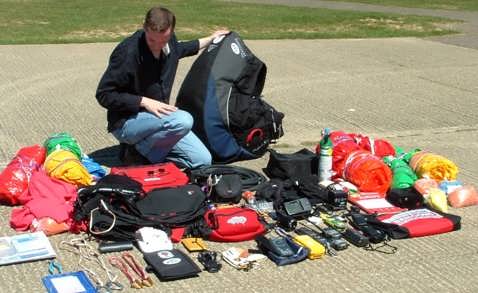 All of this--- all of that above-- says nothing of the actual flight-- the physical, real-world considerations: lift, buoyancy, ballast, material, climbing, descending, rigging, oxygen, radio communication, chase team, trajectories, airspace, high pressure gas cylinders, fittings, transponders, launching, landing, staying aloft-- WEATHER.
All of this--- all of that above-- says nothing of the actual flight-- the physical, real-world considerations: lift, buoyancy, ballast, material, climbing, descending, rigging, oxygen, radio communication, chase team, trajectories, airspace, high pressure gas cylinders, fittings, transponders, launching, landing, staying aloft-- WEATHER.
You ask how I became passionately interested.
If I was not passionately interested, none of this would happen. Instead, we would watch television.
Instead, we flew the English Channel.
 Financial Times: Why the particular project of crossing the Channel came to mind…
Financial Times: Why the particular project of crossing the Channel came to mind…
Trappe: Why the English Channel? It is only media people that ask that question. Everybody else gets it. IT’S THE ENGLISH CHANNEL.
The Channel is iconic: The White Cliffs of Dover; the Lighthouse at Dunkirk. It is a classic challenge that has called to aviators for generations, since long before you or I were born. The challenge itself is classic; one might as well ask the same question about Wimbledon, Indianapolis, or the Tour de France.
It is The English Channel; as a challenge, it stands on its own.
Financial Times: And why nobody else had done it already…
Trappe: See above.
Trust me, it would be *a lot* easier to do this illegally. One could inflate balloons in the dark of the night, launch into flight, and leave everything behind. You wouldn’t even have to visit Byzantium and pay tribute.
You could just worry about the physical complexities of the flight.
But, Mr. Moreton -- it comes back to having a genuine commitment to the safety of those we share the skies with. Not me-- not my safety. Frankly, I care very much about my own safety-- but that is secondary to the safety of those in the air with us, and those below us. I put myself into the skies; others made no such bargain. We must first protect them, and then protect ourselves.
Woah, little heavy for a bunch of balloons, isn’t it?
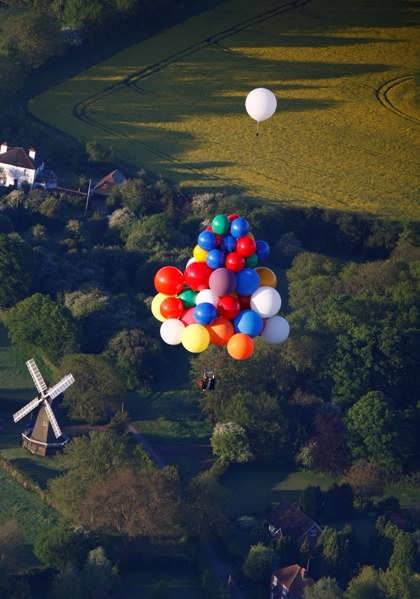 Financial Times: Why he was able to when others had not…
Financial Times: Why he was able to when others had not…
Trappe: Who’s going to do it? And, who is going to do it right? Contact the CAA in your country. Ask them what it would take for you, starting right where you are today, to fly the Channel legally, under a cluster of toy balloons.
Really.
And, we have just completed that same task-- so there should be little convincing needed. We’ve already persuaded them. The path for you, Mr. Moreton, is relatively clear.
And what for, Mr. Moreton? You could get a Ryanair ticket for fifty quid. And, you would have a reasonably good idea of where you would land.
We, Mr. Moreton, floated across the channel-- in complete silence. I will have something to keep me warm when I am old.
And annoy grandchildren. “Yes, grandpa. You told us the story of the English Channel already. Lots of times, grandpa…”
Financial Times: Whether there was a sense of deflation. Sorry. Couldn't resist. A sense of anti climax…
Trappe: On the contrary, Mr. Moreton. The feeling is of tremendous, long lasting pride. My flight was small. But, in my heart I was following in a great tradition, that of truly great adventures. Mr. Moreton, I have GPS, wind models, radios, sat phone, emergency beacons. The true adventures that went before me, the actual men and women of adventure, had none of this.
But, I was able to make my own run on the channel. What I’m proud of is that we envisioned it, planned it, brought it into existence, and executed-- with coordination and consent of the controlling authorities-- and lived an adventure that, for most of the world, would be a fantasy.
 Financial Times: And what's next…
Financial Times: And what's next…
Trappe: What makes an adventurer? I mean, really Cole-- no joke. What is it? I mean, is it in you? Is it in me?
Do you know the phrase “Dr. Livingston, I presume?” Gordon Bennett, the publisher of the New York Herald, sent Henry Stanley into the heart of Africa looking for Livingston, who had grown into a national hero. Gordon Bennett sent him-- a newspaper publisher. A media partner. A sponsor.
Mr. Moreton, we have the capability to do transcontinental, lighter-than-air flight. I do not mean this as a sky fantasy. I have a genuine, bona-fide opportunity to cross oceans in this unique form of flight-- unlike anything that has gone before. This is genuine adventure, in our modern times.
That lighter-than-air gas is precious. I need a lot of it. Where is the New Your Herald when you need it? Where is Gordon Bennett when you need him?
Maybe Red Bull.
 Part II:
Part II:
Financial Times: You read like the sort of person who is more than capable of dashing off 700 words.
Trappe: Perhaps not. Give me 7,000 words, and I will write.
I’ll leave it to you to distill.
Go.
Financial Times: What the scary moments were…
Trappe: We gave ourselves a 16 day window in which to launch. Pilots have killed themselves by giving a ‘launch date.’ They tell people they are going on a given day, and the day comes, and they go--- ignoring contra-indications to safe flight.
So, we told everyone that we would go to England, stare at the sea, stare at the sky, kick the sand, and come home without ever flying if the weather system we needed did not materialize.
Pilots have also gotten killed even when they didn’t give a specific launch date. They gave a launch window (like we did) and waited for weather. And the media asked “when will you go”--- and they delayed, waiting for weather. And the media asked "When will you go?" and friends asked, and everyone asked-- and then they just went. And, they perished. (See the Catalina to the Coast balloon race, 1964.)
This was one of the major risks of this endeavor: “Go Fever.” This is where you have pilots making decisions to fly for reasons external to the flight. For example, the two news helicopters and satellite news truck that are parked outside.
We combated this by telling everyone of the biggest risk: Go Fever. We told them that to fly safely, you have to be committed to not flying. That is, not flying when conditions will not allow. We told them we would stare at the sea, stare at the sand... (wait, I’ve used this bit on you, haven’t I?) Ad nauseam.
No 'Go Fever.'
 Then, to further combat, we had our weather specialist well removed from the immediacies of the launch site. Our meteorologist, Don Day of “Day Weather Services” was around the world, in Wyoming, and could study weather in peace. He was our sanity check. He could tell us “are you crazy? This weather system is *not* as good as you think.” And, you don’t get an expert and then ignore what they say. If you do, you might as well not get an expert.
Then, to further combat, we had our weather specialist well removed from the immediacies of the launch site. Our meteorologist, Don Day of “Day Weather Services” was around the world, in Wyoming, and could study weather in peace. He was our sanity check. He could tell us “are you crazy? This weather system is *not* as good as you think.” And, you don’t get an expert and then ignore what they say. If you do, you might as well not get an expert.
So, that was another arrow in the salvo against Go Fever. (I may be mixing my metaphors a bit. Look, I’m writing fast.)
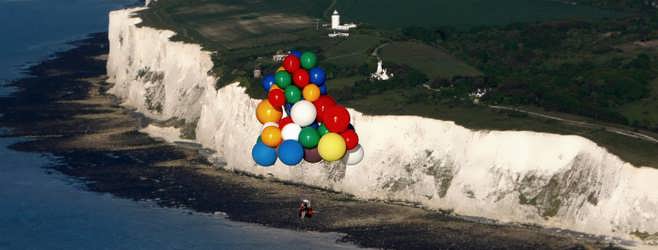
You asked about scary moments. We were in England, scrubbing the weather data every day. Our potential launch was Friday; we had rain on Thursday; rain on Saturday. The surface prog chart was covered with low pressure systems. (High pressure generally brings mild weather, and pleasant days.) We had all lows for Friday.
 But-- the low was centered just to the north. Winds characteristically flow counter-clockwise around a low. Look at the attached surface prog chart. Look at the Low directly north of Kent. Imagine all the winds swirling in a cyclonic fashion around that low-- swirling counter-clockwise. Do you see that isobar-- that line-- right across our key ribbon of water? It goes by the 'VRE' in the 'CHEVRES' printed on the map. See how that little line goes essentially from Dover to Calais, if you launch a little to the south of that isobaric line?
But-- the low was centered just to the north. Winds characteristically flow counter-clockwise around a low. Look at the attached surface prog chart. Look at the Low directly north of Kent. Imagine all the winds swirling in a cyclonic fashion around that low-- swirling counter-clockwise. Do you see that isobar-- that line-- right across our key ribbon of water? It goes by the 'VRE' in the 'CHEVRES' printed on the map. See how that little line goes essentially from Dover to Calais, if you launch a little to the south of that isobaric line?
That line was our baby.
But, Low pressure systems were all around. It rained the day prior, on Thursday, when we would be getting ready. A big weather system was coming behind us: It rained on Saturday. We had this tiny potential window on Friday.
But, surface winds were forecast to be right at the limit of what we could inflate in. In writing you, I’ve been talking mostly about the realities of flight; I’ll write you about the dream later. But, the reality is that this balloon system will readily lift a quarter-ton into the sky-- thousands of feet in the air. If winds are kicking it around, it isn’t like toy party balloons batting against the ceiling in your house. It can literally take a man off his feet. (Um, as you saw. That’s the whole point, isn’t it? Work with me here.)
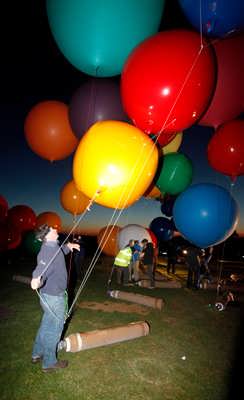 So, I was specifically worried about the inflation.
So, I was specifically worried about the inflation.
The day before the flight I had genuine concern. We entered the inflation with substantial trepidation. There is something about the dead of the night that instills dread. Maybe other balloonists are braver men than me. I was worried.
In ballooning it is customary to designate a crew chief. My crew chief is my girlfriend, Nidia Ruiz Ramirez. She has stood this aircraft many times. She has been there for every step of the testing.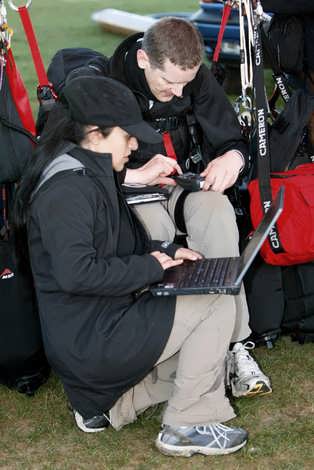
We’re supposed to start inflation at 2:00am. That is because winds are most calm at sunrise and sunset. To have a safe launch, we must go out at sunrise. It takes at least 3 hours to stand the aircraft; sunrise at your latitude this time of year is about 5:00 am. So, that would be a 2:00 am meet-time on the airfield.
But, we’re starting early. Nidia and I, and some die-hard crew, are starting at midnight. We stand the first few balloons, the core of the system. And the entire tower of balloons leans over in the wind, and nearly touches the ground. Nidia and I look at each other with dread in our eyes. “Oh shit.” We didn’t say it. We felt it, in our gut. I don’t mean that metaphorically; I felt a physiological sensation of dread manifesting.
I’m not Richard Branson; if I don’t get this flight, I pack it all in, go back to the U.S., and go back to my job. I work, a regular job. It would take me another year before I could save enough money to make another attempt-- or maybe I'd never be able to give it another try. This try, it is looking windy.
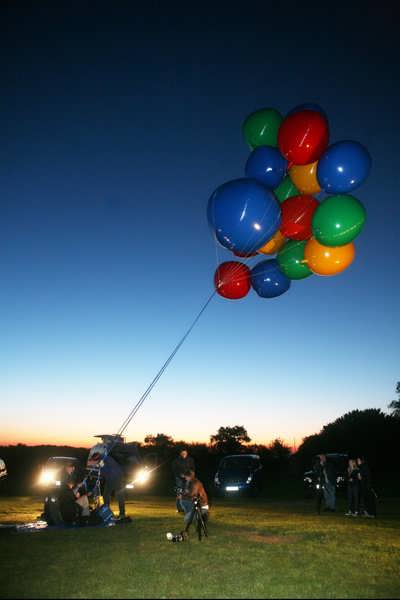
Ok, so -- the winds are laying over the core, and we may have to abort. If we try to assemble this system, these light happy balloons will be monsters in the wind.
We go slow. We change our inflation procedure. Instead of building the entire cluster, we scatter the balloons out over the airfield. Individually, they are like angry puppies. Together, they are a towering monster. That is, in the wind *on the surface* they are.
We scatter the balloons across the airfield; then, as dawn approaches, we bring them all together rapid style, to assemble the towering cluster.
Do you sail? Having a tethered balloon system is like taking a sailboat and putting the sail up, and the anchor down. Balloons do not like to tether.
Wind gods were kind; winds dropped off towards sunrise; we got the cluster built. I launched into free-flight-- and it was a tremendous relief. Once I was free of the earth, I no longer battled the winds. When you are in the air in a balloon, you move perfectly *with* the wind. There is no relative wind. It could be blowing at 50 miles-per-hour in the air, and it feels the same as 2. You move with the wind, in silence, in tranquility.
Now, landing in 50 mph winds is not advised.
 Financial Times: And how it felt…
Financial Times: And how it felt…
Trappe: Once free of the surface, it felt wonderful. I work for a global information technology consulting firm. I’m a trained pilot. I’ve flown many times. Nevertheless, I was nearly overcome. So many hours had been poured into this one little flight-- and so many people had dedicated their time to sending a person into the sky.
Once I was off the ground, all became peaceful. My track was almost exactly as forecast by our meteorologist. (Rockstar, Don Day, Wyoming.) Take a look at the two attached tracks. I’ll include a .gif, but much better if you have a free download of Google Earth. The first is the forecast trajectories if I flew at1,000, 2,000, or 3,000 feet MSL. The next document is our actual flight track.
The flight track matched the forecast nearly perfectly.
But, it was a little too much towards Ostend, Belgium. I had gotten permission from the UK CAA, and from French authorities.
I did not have permission from Belgium.
If I did nothing, I would track right to Belgium. So, I had to search out the best winds. There are invisible currents of wind in the sky, at different altitudes. Balloonists steer by climbing and descending, and selecting the most favorable wind. I searched up and down the air column for the most ‘right’ I could find. Typically you get ‘right with height’-- the coriolis effect, in the Northern Hemisphere.
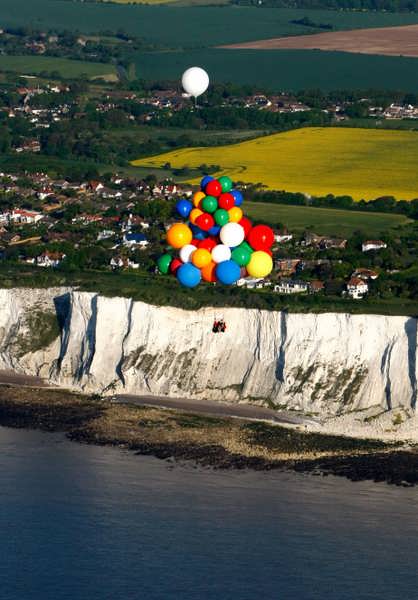
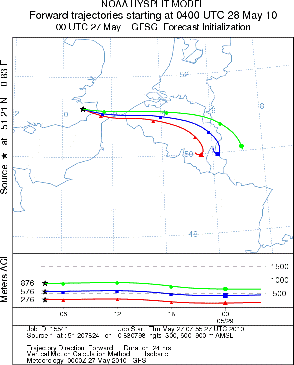
Not today. My best track was in the middle; not the surface-- that had me towards The Netherlands (after a good bit of the North Sea .) Not high-- that was towards Belgium. Somewhere in the middle. It felt great. Cole, I went right out over The White Cliffs of Dover. These cliffs have protected England when it was threatened. They are iconic; I floated directly over them, and out over the cold waters of the channel. As I departed the cliffs, my aircraft turned-- as if to give me a final, glorious view of the country I was departing. Then it continued to turn and I had England behind me, and 40 miles of open water in front of me.
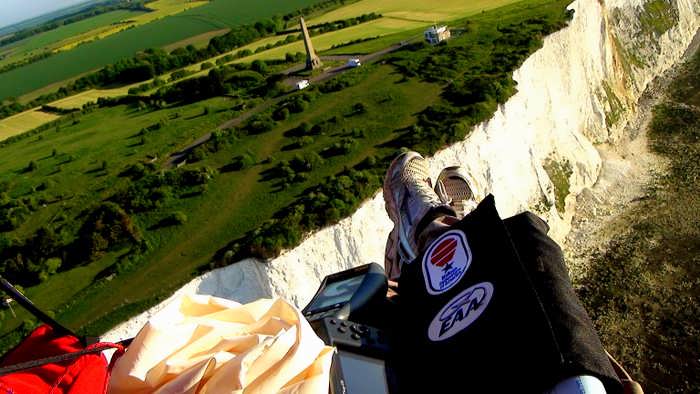
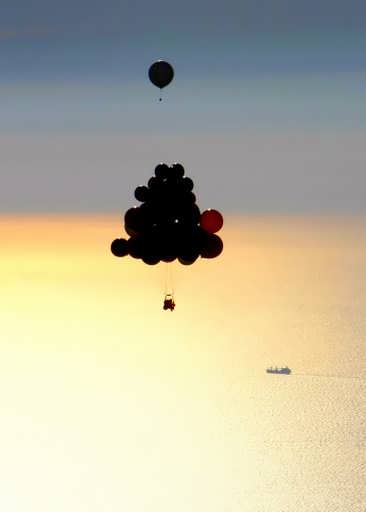 I was supposed to be chased by a helicopter. If I went in the drink, they could help coordinate rescue. After two miles, the helicopter turned back. I can’t swim two miles; I now had 38 miles in front of me.
I was supposed to be chased by a helicopter. If I went in the drink, they could help coordinate rescue. After two miles, the helicopter turned back. I can’t swim two miles; I now had 38 miles in front of me.
The helicopter was low on fuel, and we were flying so early-- launching at 5:21am BST-- that the airports were not open yet. They could (normally) fly to Calais easily; it was so early, there was no place for them to buy fuel. So, they left, back to Gatwick. I never did see them again.
Then I had that promise unique to my form of flying: silent flight. All other aircraft make this terrible noise. Gas balloons are the only aircraft that fly in complete silence. No prop, rotor, jet-- not even the winds that gliders experience. This is true, silent flight. And, unlike a commuter airplane, or a little Cessna, there was nothing keeping me from the sky. I could feel it on my skin, I could feel it in my lungs. England was behind me, the cold waters of the channel were beneath me, and the continent lay ahead.
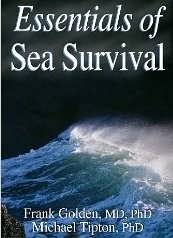 I was now alone, mid-channel. Solo flight of a gas balloon, over cold waters. We talked to the Channel Swimming Association about survival time in cold water. There is also an excellent book on cold water survival titled Essentials of Sea Survival by Dr. Frank Golden and Dr. Michael Tipton. In instances of sudden immersion, survival time in cold water is extremely limited.
I was now alone, mid-channel. Solo flight of a gas balloon, over cold waters. We talked to the Channel Swimming Association about survival time in cold water. There is also an excellent book on cold water survival titled Essentials of Sea Survival by Dr. Frank Golden and Dr. Michael Tipton. In instances of sudden immersion, survival time in cold water is extremely limited.
If you were to *wade* into the channel waters, you could have survival time of 1-2 hours in 14 degrees Celsius water (which is about what the channel has warmed up to by June.) But, in instances where people are suddenly immersed in that temperature water, survival time falls to 1-2 minutes.
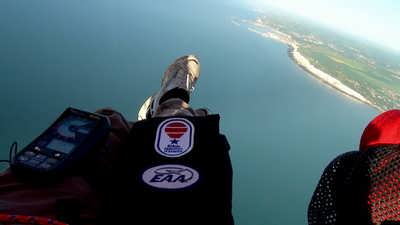 The body has a physiological response to sudden immersion in cold water, and the onset of shock occurs, followed by unconsciousness and then drowning. This happens even in shallow waters-- such as when an individual falls off a dock or pier, or falls through thin ice. This ‘cold shock’ (Golden/Tipton, p59) should reasonably be anticipated in the type of rapid immersion into the channel that I would likely experience, if ditching into the drink.
The body has a physiological response to sudden immersion in cold water, and the onset of shock occurs, followed by unconsciousness and then drowning. This happens even in shallow waters-- such as when an individual falls off a dock or pier, or falls through thin ice. This ‘cold shock’ (Golden/Tipton, p59) should reasonably be anticipated in the type of rapid immersion into the channel that I would likely experience, if ditching into the drink.
I own a cold-water immersion suit. Some media outlets mistakenly reported that I neglected this topic. But, the question is this: if you are approaching the channel waters, what would you rather do: go into the water in the suit, or throw the (heavy) suit overboard as ballast, and not enter the water at all?
I would prefer to not enter the water; that means my immersion suit would simply be so much expensive ballast. If I’m going to ballast the suit anyway, might as well just replace its weight with traditional ballast, and have more ‘fuel’ for the flight. I did have a floatation vest. But, again, you have a very limited time of usefulness consciousness in instances of sudden immersion in cold water. So, I had the vest, as required for regulatory compliance, but frankly it wasn’t likely to save one in sudden cold water immersion
 Financial Times: What it was like…
Financial Times: What it was like…
Trappe: Ok, so there I am-- mid channel, all support craft gone. The English Channel is the busiest shipping lane in the world. I’d hate to see the second busiest. Yes, there are boats and ships; there is also miles between them. And, those ocean-going vessels are massive and staffed by a comparatively small crew-- men and women who have work to do. They aren’t typically looking for a balloonist to be floating overhead.
I did have an EPRB-- a 406 mhz emergency locator beacon. This is a very serious piece of safety equipment using a satellite system developed by the Americans, Soviets, and French. Now maintained by basically the same people-- replace ‘Soviets’ with ‘Russians.’ This would help locate me in an emergency. But, it might not help much (see sudden cold water immersion, above.)
For some time, I tracked towards a French "Prohibited" airspace. This is a very serious type of airspace-- even more so than military Danger Areas or special Restricted areas. This is "Prohibited"-- NO FLY. It was French P26, Gravelines-- a nuclear power station.
The Channel Cluster: Flight Track Note Prohibited airspace surrounding nuclear power station (in orange cylinder); the balloon aircraft was above the ceiling of this airspace, as well as the nearby Class C airspace surrounding Calais. (Volare Magazine, Stefano Tartarotti) |
|---|
And yet, with all this, it was tremendously peaceful. I floated in Silence. I capitalized that intentionally. I said before that no other aircraft fly in complete silence. But consider this: most things don’t even move in complete silence, even on the surface. I’m traveling at up to 30 knots, without any sound, without any wind. You can’t even walk in complete silence.
But you can float.
I descended to be near the water; I wanted to be close to that ribbon that separated Great Britain from the continent. Starting at 1,000 feet, I could hear the waves. I challenge you to find any other aircraft that can hear the sound of gentle waves from 1,000 feet.
I made landfall over the Lighthouse at Dunkirk.
I moved inland, away from the shore, and chose my landing area-- one mile short of the border with Belgium.
You asked how it felt; Cole, we accomplished what we set out to do.
End. June, 2010.

For the Channel Cluster, With Great Appreciation:
My heartfelt thanks go to:
- Our outstanding crew for their excellence on the airfield; I would never have had this opportunity without you; it is this team-- YOU-- that enabled this dream adventure; Your dedication to our sport and to aviation was apparent: many were early for a 2:00am meet-time! (Crazy Brits.)
- Sponsors BOC, a member of the Linde Group, for that precious, invisible, beautiful lighter-than-air gas;
- Robin Batchelor, for being our man on the ground in England! Robin got us started, got us settled, and got us launched. (And, he was quite the ballooning commentator for Sky News!)
- The Kent Gliding Club, for hosting us at the oldest gliding club in England, for hosting our most unusual craft on your airfield, and for airborne camaraderie in the skies (I still say that a powered glider is cheating;)
- Don Day, Meteorologist, for helping us to read the skies, ride the winds, and arrive safely;
- Liz and Glen for local pilot advice, for helping us scrub the weather data, for standing the balloons in the dead of night, for having us in their home, for custom cut aerials, and so much more!
- Friends at the UK CAA, for evaluating our unusual aircraft based on its merits, and for the tremendous professionalism shown throughout the process;
- Dr. Mark Karpel, for his intellectual inquiries and reportage on this unique way of traveling the heavens;
- Tony Holden, for dedication and a leadership flair of resounding authority and inspired military precision! Downright rousing, it was!
- Henry Beams, for his endless stream of bright-eyed questions, and boundless enthusiasm;
- Tim Ward, for the dedication it takes to drive 400 miles to inflate the system in the dead of night, and especially for finding a quiet moment amid all the noise before launch to remind me to enjoy it; Poetic, Tim;
- The Smithsonian's Air & Space magazine, for coverage of our flight;
- Dave Palmer, for outstanding graphics, and for helping us develop sponsorship for our unique sport;
- Maurizio Gunelli for the outstanding article in Volare, in Italy;
- Stefano Tartarotti for his beautiful graphic depicting the crossing;
- Ballooning Journal, for its gracious coverage of our flight;
- Sam Barcroft, Jack Fletcher, Ben Churcher, Nick Obank, Ruaridh Connellan & James Nye for expertise in their specialties;
- Rik Kornet of ProBalloon in Holland, for an outstanding Mode-S transponder;
- The Family Eimers, for hosting us at the Gladbeck Gasballon Startzplätz, and for helping test our cluster balloons....with hydrogen [!]
- Bennie Bos for lighter-than-air friendship, and for telling our stories in Dutch!
- Cole Moreton for patience and humor as we discussed the flight for Financial Times;
- Friends at Sky News, for warm, friendly, and colorful coverage of our journey throughout the flight; we hope your viewers enjoyed a nice story; we enjoyed your beautiful British skies;
- Endless thank you to Nidia Ruiz Ramirez.
The English Channel:
Magazines:
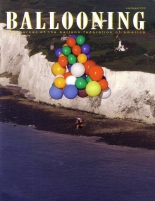 |
||
|---|---|---|
| Ballooning Journal |
 |
 |
|
|---|---|---|
| Guardian Weekend - UK | Sports Illustrated - USA |
Selected Additional Accounts:
Resources:
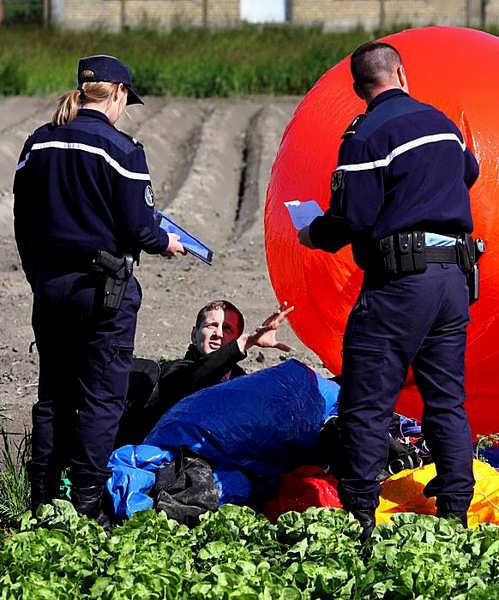
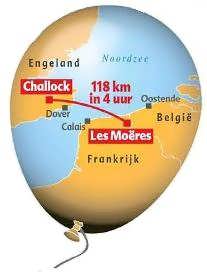
~FIN~




